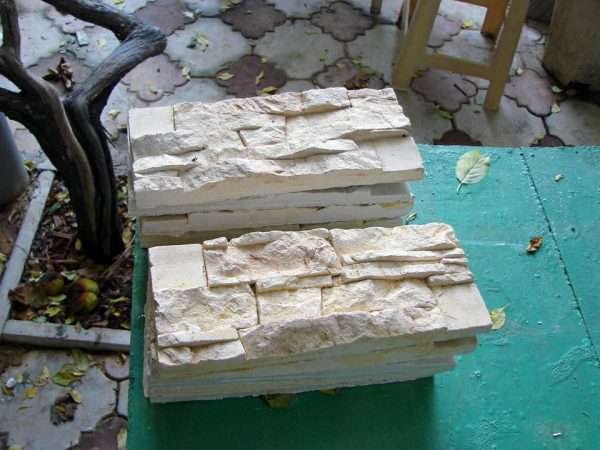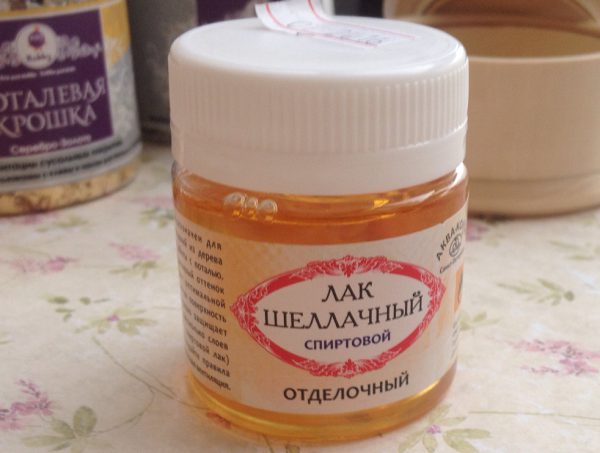Gypsum is a mineral of plant origin. This is a popular finishing material: gypsum tiles are used in the interior, gypsum mixtures - in construction, medicine, art. But this material requires mandatory protection against destruction, since its surface is brittle. For this purpose, a special varnish for plaster is implemented, which helps to make a beautiful finish under natural stone.
- Application of gypsum
- Plaster varnish - types and benefits
- Shellac material
- Acrylic lacquer
- Oil varnish
- Yacht varnish
- Decorative stone painting
- Staining rules
- Instruments
- Stone preparation
- Coating
- Methods of coloring and their subtleties
- Marbled
- Under the terracotta
- Under bronze
- Stain
- Tips & Tricks

Application of gypsum
Gypsum stone is produced in factories, but, if desired, it can be made from dry powder with your own hands. You just need to mix the product with water, pour the solution into the mold, let it harden. A beautiful figurine, tile or other product will be ready. To give a specific color, various paints and pigments are added to the mixture, sand and modifiers are added to strengthen the strength.
Gypsum stone often has the appearance of artificial brick, tiles, because it is used for wall cladding, doors. It goes well with other materials - wood, tile, plaster, wallpaper, photo wallpaper. Gypsum is suitable for a complete and fragmentary decoration, often they are faced with fireplaces, emphasize the base of the columns. All construction stores sell plaster stucco moldings, moldings for walls and ceilings.
Gypsum powder is used to create sculptures, garden figures, figurines. On its basis, building mixtures are made for external works, internal repairs. Dry gypsum is an excellent bonding component of plasters and putties, adhesives, and other building and finishing materials. Why are professionals choosing it? The material has many advantages:
- attractive appearance;
- light weight combined with durability;
- the ability to make a unique decor;
- creation of a layer of sound and heat insulation;
- environmental friendliness, harmlessness to humans;
- no risk of mold, mildew;
- vapor permeability;
- simplicity in processing and laying on different surfaces;
- Easy shape changes with the available tools.
Plaster varnish - types and benefits
Many people prefer to paint gypsum, because most often it is sold in its original (gray-white) form. Painting will reduce the hydrophobicity of the material, which is glued to special formulations. The decoration of the stone may include the application of a special protective lacquer layer.
Varnishing is usually done 5-10 days after the end of the tile laying, to pre-allow the glue to dry completely. Lacquer for decorative stone made of gypsum can have different composition and properties. Many paints and varnishes are affordable, safe, allow the base to breathe, do not clog it. Varnishing helps to reduce the rate of destruction and make the coating durable and attractive in appearance.
to contents ↑Shellac material
This type of varnish is most often used in finishing and decoupage works. It has an alcohol base, is recognized as an excellent coating material for gypsum.Shellac can be applied to all types of paints, it looks especially good on metallic. The tool provides fine polishing, it is also used for furniture processing.
to contents ↑Shellac can itself give a certain color to the gypsum stone, as it is both transparent and colored. Some tint varnishes provide the effect of artificially aged tiles. Often, masters prefer to impregnate gypsum with a mixture of shellac and rosin 1: 1, after which the appearance of spots is completely eliminated. Outwardly, the tile at the same time becomes like marble.
Acrylic lacquer
This type of varnish includes the main polymer - acrylic, as well as resins, modifiers, and has a water base. It is not too thick, looks more like cream, is used for external and internal work. Acrylic varnish is usually used for topcoat, as it creates a durable film with a water-repellent effect. The polymers in the varnish will protect the tile from burnout, the action of ultraviolet rays.
The stores have matte, glossy, semi-matt acrylic varnishes. Gloss gives the plaster a gloss, but strongly reflects light, which must be taken into account when painting. Matte varnishes, on the contrary, give solidity, look expensive and spectacular. All acrylic compounds are harmless to the body, their drying is quick, easy application. After drying, the paintwork will become transparent and completely preserve the external attractiveness of the stone.
to contents ↑Oil varnish
Oil varnish is also suitable for application on the basis of gypsum. The composition of the material is artificial resins, herbal additives, it has an oily texture. After application, it forms a film that protects the base from destruction and the action of damaging factors. Oil varnishes can also be matte and glossy. For their dilution, special solvents are used. The stores have shade materials that give the tile a beautiful color. After drying, the oil varnish darkens, this should be considered by the designer.
to contents ↑Yacht varnish
Such a varnish is also made on the basis of oil, but it has higher strength characteristics. It is applied in a very thin layer, because getting rid of drips is problematic. Drying of this product lasts at least a day, at low temperature in the room this time is even longer.
to contents ↑Decorative stone painting
To coat gypsum stone with varnish is an excellent opportunity to improve the operational and decorative properties of the material. It is possible to choose coatings according to individual preferences - in terms of color, gloss power and other characteristics.
Staining rules
For optimal results, the following recommendations should be observed:
- All gypsum products, individual elements must be well dried before starting work. The glue must be dry, as well as previous layers of the coating (for example, paint or enamel).
- Before working with figurines, figurines, other products, they must be kept at room temperature for at least 24 hours. Otherwise, the varnish can quickly lose its performance.
- Coarse parts must first be sanded. It is better to do this before sticking to the walls, because then the process will cause difficulties.
- If an additional impregnation application is planned, it is important to carefully read the instructions for the specific material. Some impregnations are applied before varnishes, others - after them, others are not combined with varnish at all.
It must be remembered that shiny varnishes weaken the effect of naturalness, but give a feeling of festivity. If the room is made out in the styles striving for naturalness, it is better to buy opaque coatings.
to contents ↑Instruments
The choice of tools will depend on the staining method. For applying varnish, you can use a roller, brush, sponge, spray gun (airbrush). Small brushes are usually used to tint hard-to-reach areas. If the product needs grinding, you will need an emery cloth or grinder, as well as a vacuum cleaner to remove dirt and dust. Also need to cook:
- rags;
- degreasing solution;
- impregnation (if required).
Conventional paint brushes made of natural materials, fleecy rollers for varnishing of gypsum stone are not suitable. In this case, the varnish consumption will be very large, streaks will appear on the surface. In general, you need to work carefully with a brush: drips, stains cannot be avoided even by the most experienced master. But you can’t cope without a brush if you have to paint “torn” areas of the cladding.
A great advantage over other methods of applying varnish is spray. The airbrush will provide uniform coverage of the base, the surface will become plain. By changing the distance from the nozzle, you can give different effects when varnishing. Also, only with the help of an airbrush it is possible to make a smooth transition between darkened and brighter areas.
For painting and varnishing, it is not necessary to use expensive devices. Suitable even the cheapest airbrush - airbrush. It is only important to pay attention to the quality of the compressor - the final staining result depends on it.
to contents ↑Stone preparation
Preparatory activities are simple. It is necessary to remove dirt and dust from gypsum parts, but the material cannot be moistened. If necessary, it is polished, after which dust is again brushed off from it. Then the selected type of impregnation is applied (for example, to increase moisture resistance or with antiseptic properties). After impregnation, the gypsum tile must be allowed to dry well.
Coating
Staining is done in the selected way. Each part is painted separately so that there are no dry areas. Otherwise, the edges of the tile will be white. Often they paint in two colors - darker and lighter, then the work is carried out according to a pre-compiled scheme. Tiles with pronounced embossment should be treated with a spray gun - you can’t do it with a standard brush. There is another option for staining - immersion of each part in a solution of a coloring material. But consumption in this case may increase, and it will be inconvenient to paint large products.
to contents ↑
Methods of coloring and their subtleties
Painting gypsum may not be quite ordinary, with a variety of effects. Some give the stone an aged look, others - a special ebb.
Marbled
Purchased at the store products can withstand 48 hours at room temperature. If gypsum tiles are made with their own hands, they provide complete drying. Then they heat up the drying oil, carefully impregnate the gypsum surface twice. You can not skip even the smallest sections. After drying, drying oils can be applied with a matte varnish (colorless). The surface will acquire a marble look "antique".
Under the terracotta
Shellac (pure or mixed with rosin) is used as a coating composition. LKM is slightly diluted with technical alcohol. In a few days, the surface will be similar to terracotta (it will acquire a brownish color).
to contents ↑Under bronze
Gypsum is well impregnated with drying oil, dried up to 10 hours. Next, bronze powder is prepared, diluted with any varnish, applied in two layers to the product. Dry the material again. Then make such a solution:
- 10 g of silver nitrate;
- 300 g of water;
- 100 g of vinegar essence.
Plaster parts are coated with such a solution directly on the bronze layer. As a result, the powder is oxidized. Then the base must be wiped with a velvet cloth. Additionally, you can treat the surface with wax.
to contents ↑Stain
The stain is usually applied with a spray gun, but the effect will be even better when immersing products in this tool for 10 seconds. Pre-stain is heated a little. After application, the gypsum parts are dried.
to contents ↑Tips & Tricks
Since gypsum is a vapor-permeable material, over time it becomes like a natural stone. This makes it desirable in many types of interior.Professionals recommend using an acrylic primer diluted with water before starting work. After applying the layer and drying it perform all other work. Painting gypsum tiles and figurines with your own hands is not difficult, but such material has many advantages, and the effect will be exactly as intended by the user.















Hello. I need a varnish for processing gypsum tiles. The surface will heat up to about 100 degrees. I am interested in acrylic varnish and shellac. Will they fit? Which is better? Their consumption per square meter
The melting temperature of shellac varnish is 80-120 ° C, acrylic melts at 260 ° C, and changes color when heated to 180 ° C. Therefore, shellac is definitely not suitable.
Consumption depends on the manufacturer, but on average it will be 120-200 g / m² first layer, 100 g / m² second layer.
Hello, please tell me how to properly restore wooden entrance doors (as a result of exposure to freezing temperatures, the sun and rains, the varnish with which they were covered peeled off and peeled off in places).